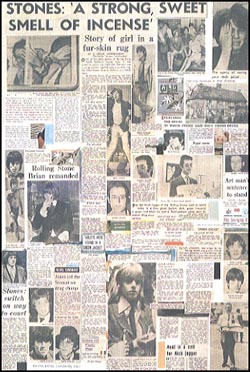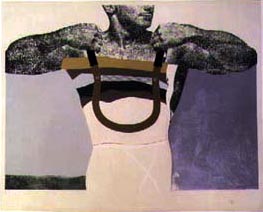
Richard Hamilton

Born in 1922 in London. In 1934 he attended evening classes in art. In 1936 he worked in the publicity department of an electrical company. He studied at Westminster Technical College and St. Martin's School of Art. In 1937 he worked in the publicity department of the Reimann Studios. From 1983 to 1940 he studied painting at the Royal Academy Schools. He enrolled for a course in technical drawing and worked as a draughtsman from 1941 to 1945. He was readmitted to the Royal Academy Schools in 1946 but was expelled in the same year as a result of apparently unsatisfactory work. He began his National Service. In 1947 he married Terry O'Reilly. He studied painting at the Slade School of Art in 1948-51. His etchings from this period were exhibited at his first one-man exhibition at Gimpel Fils, 1950. The first exhibition he designed himself was Growth and Form at the ICA, London, 1951. In 1952 he became a teacher of silver work, typography and industrial design at the Central School of Arts and Crafts. One of his colleagues there was Eduardo Paolozzi, with whom Hamilton was a founder member of the Independent Group at the ICA. This was a group of artists and intellectuals who met to discuss cultural change in the age of technology.

In 1953 he became a lecturer in the Fine Art Department at the King's College in the University of Durham. In this post he worked with Victor Pasmore and taught a course in basic design which was also attended by art students. In 1955 he exhibited his paintings at the Hanover Gallery, London. His paintings at this time were influenced by Cubism. In the same year he devised and designed the exhibition Man, Machine and Motion at the ICA. In 1956 he made his first Pop collage as a design for the poster and catalog of the exhibition This Is Tomorrow at the Whitechapel Gallery, which he had helped to organize with other members of the Independent Group. From 1957 to 1961 he taught interior design at the Royal College of Art. In 1960 he was awarded the William and Norma Copley Foundation Prize for Painting. He also published a typographical version of Marcel Duchamp's Green Box.
His wife died in a car accident in 1962. In 1963 he visited USA for the first time. In 1965 he began his reconstruction of Marcel Duchamp's Le Grand Verre. He organized the Duchamp retrospective at the Tate Gallery in 1966. His works on the theme of the Guggenheim Museum were also shown at the Robert Fraser Gallery. In 1969 he helped to make a film of his work for the Arts Council. In 1970 he showed his Cosmetic Studies. He was awarded the Talins Prize International, Amsterdam, 1970. In 1977 and 1978 he collaborated with Dieter Roth at Cadaqu�s. He was given his first comprehensive retrospective exhibition in 1979 at the Tate Gallery, also shown at the Kunsthalle, Berne. In 1974 he had retrospectives at the Guggenheim Museum, New York, the St�dtische Galerie, Munich, and the Kunsthalle, T�bingen. In 1982 his writings, notes and documents were published by Thames and Hudson, London.
His
works of the 1950s are of great importance to the development of
British Pop. Many works of this period, such as $he and Homage a
Chrysler Corp, were concerned with exploring the language of
advertising and commercial art and the respective qualities of
man-made and mechanically produced imagery.
�